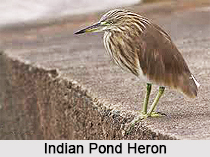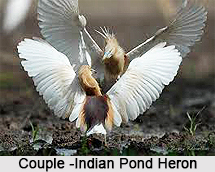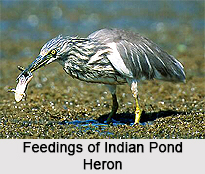 Indian pond heron or paddybird is an Indian bird with a scientific name "Ardeola grayii" is a small heron.
Indian pond heron or paddybird is an Indian bird with a scientific name "Ardeola grayii" is a small heron.
Indian pond heron are widespread and common but can be easily missed when they stalk prey at the edge of small water-bodies or even when they roost close to human habitations.
Structure of Indian Pond Heron
Indian pond heron are distinctive in looks when they take off with bright white wings flashing in contrast to the cryptic streaked olive and brown colours of the body. Their camouflage is so excellent that they can be approached closely before they take to flight, a behaviour which has resulted in folk names and beliefs that the birds are short-sighted or blind. They appear stocky with a short neck, short thick bill and buff-brown back.
Seasonal Changes of Indian Pond Heron
In summer, the adult Indian pond herons have long neck feathers. Its appearance is transformed from their dull colours when they take to flight, when the white of the wings makes them very prominent. It is very similar to the squacco heron, Ardeola ralloides, but is darker-backed. To the east of its range, it is replaced by the Chinese pond heron, Ardeola bacchus.
Breeding Season of Indian Pond Heron
The breeding season of Indian Pond Heron begins with the onset of the monsoons. During the breeding season, Indian pond heron appears with red legs. The numbers do not suggest that this is a normal change for adults during the breeding season and some have suggested possibility of it being genetic variants.
Races of Indian Pond Heron
The race phillipsi of Indian pond heron has been suggested for the populations found in the Maldives, however this is not always recognized. It forms a super species with the closely related Chinese pond heron, Javan pond heron and the Madagascar pond heron.
They are usually silent but may give a harsh croak when flushed or near their nests.
Habitats of Indian Pond Heron
Indian pond heron`s feeding habitat is marshy wetlands. They usually feed at the edge of ponds but make extensive use of floating vegetation such as water hyacinth to access deeper water. They may also on occasion swim on water or fish from the air and land in deeper waters. They have also been observed to fly and capture fishes leaping out of water. Sometimes, they fly low over water to drive frogs and fishes towards the shore before settling along the shoreline.
Feedings of Indian Pond Heron
The primary food of Indian pond heron includes crustaceans, aquatic insects, fishes, tadpoles and sometimes leeches. Outside wetlands, these herons feed on insects.
Nests of Indian Pond Heron
Indian pond herons nest in small colonies, often with other wading birds, usually on platforms of sticks in trees or shrubs. Most nests are built at a height of about 9 to 10 m in large leafy trees. The nest material is collected by the male while the female builds the nest.
Eggs of Indian Pond Heron
Indian Pond Herons lay three to five eggs are laid. The eggs hatch asynchronously, taking 18 to 24 days to hatch. Both parents feed the young. Fish are the main diet fed to young. The nest sites that are not disturbed may be reused year after year.











